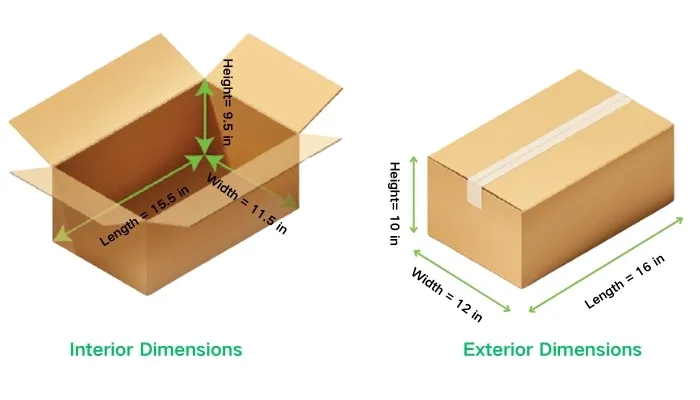Mastering Box Measurements: The Key to Efficient Shipping.
Welcome to Mastering Box Measurements 101. Today, we’re tackling a seemingly simple but crucial topic: how to measure a box. Accurate box measurements can save you significant money, especially regarding shipping costs. Let’s dive into box dimensions and discover why understanding interior and exterior dimensions is vital for effective shipping.
Understanding Box Dimensions
Boxes have two sets of dimensions: interior and exterior. Knowing the difference between these can be the key to efficient packaging and cost-effective shipping.
Interior Dimensions: Ensuring the Perfect Fit
Let’s start with the interior dimensions. These measurements are essential for determining the right size of the box for your products. When you order boxes, the dimensions you encounter online or in catalogs are always interior measurements, listed as length, width, and height.
When ordering custom-sized boxes, it’s crucial to measure to the nearest tenth of an inch and specify these as interior dimensions. This precision ensures that your products fit snugly and securely inside the box, minimizing movement during transit and reducing the risk of damage.
Exterior Dimensions: Calculating Shipping Costs
Once your product is snug inside the box, the focus shifts to the exterior dimensions. These are measured from the edge-to-edge of the corrugate, again by length, width, and height.
Exterior dimensions determine how much space your package occupies during transit, which is directly linked to shipping costs. Shipping carriers use a method called dimensional weight shipping, where both the weight and volume of your shipment are considered. Understanding exterior dimensions helps you anticipate shipping expenses and optimize pallet loading for high-volume shipments.
 Measure the interior and exterior dimensions of a box for accurate shipping calculations.
Measure the interior and exterior dimensions of a box for accurate shipping calculations.
The Financial Impact of Accurate Measurements
Inaccurate box measurements can lead to unexpected costs. By properly measuring both interior and exterior dimensions, you can avoid costly mistakes. Proper measurements ensure that you’re not paying extra for oversized packages and that your products are safely and efficiently transported.
Practical Tips for Measuring Boxes
1. Use the Right Tools: A reliable measuring tape or ruler is essential for accurate measurements. Ensure you’re measuring from edge to edge for exterior dimensions.
2. Consistency is Key: Always measure in the same order: length, width, height. This consistency ensures clarity when communicating dimensions.
3. Consider Custom Needs: If your products require custom packaging, communicate dimensions clearly with your box supplier to ensure a perfect fit.
Why Accurate Measurements Matter
Understanding box dimensions isn’t just about fitting products or calculating shipping costs. It’s about ensuring efficiency in every step of the supply chain. Properly measured boxes lead to better space management, reduced material waste, and optimized shipping strategies. Ultimately, this knowledge contributes to a more sustainable shipping process.
Navigating Where Your Box Fits in the World
Measuring boxes accurately helps determine not just what fits inside but also how your box fits into the larger logistics puzzle. It’s a metaphor for finding your place in the world—both in shipping and beyond. If you ever find yourself questioning your place, perhaps a call to your mom might offer some perspective and reassurance.
Conclusion
In the world of shipping, mastering the art of box measurement is a small yet powerful tool. By understanding and applying the principles of interior and exterior dimensions, you can enhance efficiency, reduce costs, and contribute to a smoother, more effective shipping process. Remember, measuring isn’t just a task—it’s a strategy. Happy shipping, and may your boxes always fit perfectly!


